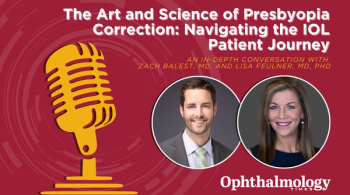
Preoperative antibiotics key to controlling complications
Rockville Centre, NY—Gatifloxacin 0.3% (Zymar, Allergan), a fourth-generation fluoroquinolone, achieved excellent penetration into the cornea, far exceeding the minimum inhibitory concentration (MIC) values for several ocular pathogens, according to John R. Wittpenn, MD.
Possible infectious complications following ocular surgery include endophthalmitis after cataract extraction and infectious keratitis after refractive surgery. The potential for these sight-threatening complications underscores the importance using antibiotics to decrease the risk of developing such complications, emphasized Dr. Wittpenn, a partner in Ophthalmic Consultants of Long Island,Rockville Centre, NY.
"The standard of care for any surgical patient according to the Centers for Disease Control and Prevention includes the presence of antibiotic at the surgical site at the commencement of surgery. The preoperative use of a topical antibiotic prior to surgery inhibits growth of bacteria on the ocular surface and allows the antibiotic to become concentrated in the corneal stroma, thereby establishing a diffusion gradient," Dr. Wittpenn said.
The corneal stromal level, Dr. Wittpenn explained, is the more precise indicator of the amount of drug present at the site of surgery during cataract and LASIK surgeries. The total corneal concentrations may not accurately reflect stromal levels due to possible high concentrations within the epithelium. Dr. Wittpenn is also an associate clinical professor in the department of ophthalmology, State University of New York at Stony Brook.
Dr. Wittpenn and colleagues conducted a study to determine the concentrations of gatifloxacin in the corneal stroma and aqueous humor of 50 patients after presurgical prophylaxis. All patients were undergoing penetrating keratoplasty for corneal edema or keratoconus, and all received gatifloxacin 0.3% ophthalmic solution four times daily for 3 days before surgery and then 1 drop every 15 minutes in the hour before the surgery.
"Patients undergoing penetrating keratoplasty were chosen as the patient population because of the relative ease of corneal sampling during this procedure," he explained.
During surgery the corneas were de-epithelialized and frozen for later analysis. The concentration of gatifloxacin in these specimens represents the concentration in the corneal stroma, according to Dr. Wittpenn. Some fluoroquinolones, such as ciprofloxacin, precipitate heavily on the epithelial surface. Therefore, measurements of the entire corneal button including the epithelium may be significantly higher due to high concentrations of drug in the epithelium that will never be able to penetrate into the stroma and aqueous. Therefore, the gatifloxacin measured in this study represented only the intracorneal concentrations, which is a much better indicator of the ability of the drug to penetrate the cornea.
The investigators also obtained aqueous specimens from nine patients. All samples were frozen at -70°C until analyzed by high-pressure liquid chromatography (HPLC) using a reverse-phase HPLC procedure that had been previously been validated with modifications.
Dr. Wittpenn reported that 39 corneas had detectable gatifloxacin levels, 10 corneas had undetectable levels (nine of the 10 occurred in the same analysis) likely the result of storage problems, and one cornea thawed during transport. In addition, nine aqueous humor specimens had sufficient fluid for analysis.
The mean concentration of gatifloxacin at the corneal level was 15.9 μg/mg (standard deviation ±14.4 μg/mg; range, -1.1 to 54.1 μg/mg). The mean concentration in the aqueous humor specimens was 1.00 μg/ml.
Newsletter
Don’t miss out—get Ophthalmology Times updates on the latest clinical advancements and expert interviews, straight to your inbox.
















































.png)


